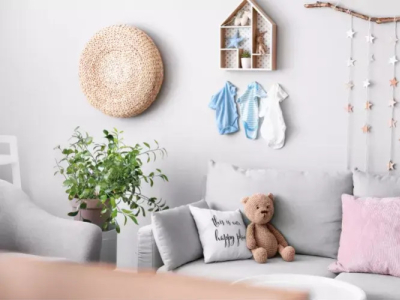
How to put baby to sleep?
Sleep safely
On your stomach or on your back? Baby is so frail when it comes out of its intrauterine cocoon, and we don't always know how to go about it. The first gestures are not innate! So how do you put your baby to sleep without taking any risks? Precautions are necessary to put baby to sleep safely, but which ones?

What position should he sleep in?
Lay your infant on his back at night and for all times of sleep (including a short nap during the day). Indeed:
- sleeping on your stomach can interfere with your breathing;
- Laying on your side is an unstable position, which makes it easier to turn onto your stomach.
However, do not use devices to hold your baby on your back (e.g. rolled towel, cushion) because they can also hamper his breathing; when your child is old enough to roll over on his own, don't force him to lie on his back.
Getting baby up and down gently
It's your first steps with baby at bedtime and he's so fragile that you don't know how to "tear" him out of his little cocoon bed, any more than you manage to "untie" him from your loving arms. to put him to bed!
To lift him when he is lying on his back

- Ride your left hand down his lower back, under his buttocks.
- Slide your right hand under his neck and head and gently lift him up. -
- Before 2 months, your toddler has no control over his neck or his muscles, so you need to support his body and head perfectly so that they don't wobble.
- Rotate his buttocks on your left hand and, with your right hand, bring him into the bend of your elbow… or on your shoulder, his head nestled in the palm of your right hand.
To put him back on his back
- Using your left hand, support his head. With your right hand, support his lower back.
- Lie him down slowly. Release your right hand as her upper back touches the mattress, with your left hand continuing to support her head.
- Gently lower her head, guiding it with both hands, so she doesn't falls” not suddenly.
Thanks to the raised baby bed Lit'bellule, all these gestures are made easier! No false movements, risk of hurting baby unintentionally. The height position for the first months has been designed as much for the well-being of baby as that of the parents.

What bedding to use for a baby?

When choosing and installing furnishings for your baby's room, be mindful of several things.
- Which baby beds?
- Is investing in a crib essential? No, not really, because you won't be using it for very long. Indeed, as soon as your baby starts to turn over, around 4 months, it is recommended to install him in a crib, to prevent any risk of falling. The cradle remains a pleasure purchase!
- Choose a crib (essential until the age of 2) with a slatted base (it reduces the presence of dust mites and therefore the risk of respiratory allergies).
There are different types of cribs: classic crib 60X120, convertible crib 70X140 with or without adjustable bed bases. The Lit'bellule evolutive baby bed is the bed with bars that allows you to put baby to sleep in peace in a real cocoon thanks to its tall, rounded shapes.
- Which mattress for babies?
Unlike a child or an adult, the baby needs soft sleeping comfort: we are talking about foam weight between 18 to 38kg /m3 against 35 to 55 kg/m3 for an adult. The dimensions of the mattress must be adapted to those of the bed, to avoid any risk of suffocation.
For a children's bed, the dimensions of a mattress are 60x120 cm or 70x140 cm. The thickness must be between 12 and 15 cm in accordance with NF safety standards. It must also meet the fire-resistant standard EN 597-1.
Latex, memory foam, with a natural mattress core (enriched with bamboo fiber, for example), organic cotton...there are several materials quality. The thickness of the mattress guarantees you long-lasting comfort. It takes about 12 cm for a quality product. Also, air must circulate in the mattress to allow good ventilation and breathing and to regulate Baby's temperature as well as possible. Anti-bacterial/mite processes, natural fabrics and foams as well as removable mattresses (the best for easy washing) as well as high-end products such as cashmere fabric are appreciated by mothers. French manufacturing as well as eco-designed products respecting standards such as CERTIPUR® and OEKOTEX®, are quality commitments.
Discover our mattresses natural products made in France
How best to install your child for the night?

To ensure that your baby sleeps comfortably:
- prefer overpajamas or a sleeping bag (or "turbulette"), well suited to his size.
- Avoid multiple layers of clothing, so that your child does not get too hot. To check if he is comfortable, place your hand on the back of his neck: you should not feel sweat under your fingers. -
- Prohibit any necklace, chain or cord with a pacifier. These objects could interfere with your child's breathing during sleep.
- If you use a pacifier, offer it to your baby for a nap and/or for the night, at bedtime. In any case, do not force your child to take the pacifier, and do not place it in his mouth when he sleeps. -
- Never give your baby sleeping pills: they are dangerous and habit-forming.
- Similarly, do not get used to your child not to fall asleep with his bottle or a pacifier coated in a sugary solution. This practice could indeed promote the appearance of dental caries.
Objects in the bed
To prevent any risk of the baby burying himself and not hamper his breathing, do not leave any soft objects in the bed. Thus pillows, duvets, eiderdowns, sheepskin, bulky stuffed animals that may cover the child's face are to be avoided.
The bumper is not recommended either. However, if you want to use one, it must be thin, firm, well attached to the bed and not padded, so that baby does not sink into it.

In what mood should your child sleep?

- Opt for naps in natural light and overnight sleep in the dark. This helps your baby to adopt a different rhythm day and night.
- In addition, the room must maintain a temperature of 18 to 19°C, and be ventilated every days.
- be aware that passive smoking is very harmful for both the fetus and the baby. Also, do not smoke or allow anyone to smoke in the presence of your child. In particular, preferably entrust its care to a non-smoker;
- prohibit your pet from entering the baby's room. Indeed, he could lie in the crib close to his face, with a risk of suffocation.
What prevention for sudden infant death?

- In addition to sleeping on the back mentioned, it is also recommended to put the baby on a firm mattress and the dimensions of the bed.
- Set the temperature of the room around 18- 19°C.
- Avoid duvets and blankets in favor of an overpajama, sleeping bag or sleeping bag. Indeed, if the baby has multiple defense mechanisms against the cold, he fights the heat very badly. Also avoid co-sleeping! -
- ventilate his room for at least twenty minutes every day.
Since the 1990s, the number of sudden infant death syndromes has fallen by more than half thanks to sleeping tips. But, for the past few years, the number of deaths has unfortunately remained stable. Hence the importance of observing but also of regularly recalling all these preventive measures.
Sleep is very important in a baby's life. Sleeping well allows his nervous system to build and improve, recover from nervous fatigue and strengthen his immunity against microbes.


